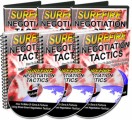Salespage Snapshot

Table of Contents
Introduction.6
Chapter 1 – The Importance of Time Management.8
The Benefits of Time Management9
How Ineffective Time Management Can Hurt Your Business11
Chapter 2 – Applying the Pareto Principle to Your Business ..12
The Importance of the Pareto Principle 13
Applying the Pareto Principle to Your Business ..14
Chapter 3 – Understanding Parkinson’s Law and How To Use It To Your
Advantage .17
Running Against the Clock .19
Crush the Cockroaches of Productivity.20
Implement the Pomodoro Method ..21
Chapter 4 – Prioritize Your Projects and Tasks Using the Eisenhower Matrix
..23
The Four Quadrants of the Eisenhower Matrix.24
Using the Eisenhower Matrix to Increase Productivity..27
Chapter 5 – Why Having a Routine Can Help You Manage Your Time Better
..28
Create a Chart ..29
Avoid Social Media Distractions ..30
Stay Focused.30
Reorganize Around Time.31
Greater Achievements ..32
TIME MANAGEMENT FOR ENTREPRENEURS
More Free Time 32
Increases Productivity33
Avoid Procrastination.33
Become More Disciplined 34
Chapter 6 – Improve Your Time Management By Learning to Delegate and
Outsource..36
Learning the Art of Delegation ..37
Outsourcing Tasks for Better Time Management 38
Why You Should Outsource the Work ..39
Types of Tasks You Can Outsource..40
Chapter 7 – How Building Good Habits Can Improve Your Time
Management.42
Focusing on Physical Health .43
Focusing on Mental Health with Meditation 45
Chapter 8 – Tools and Apps to Help You Increase Your Productivity and
Manage Your Time47
Google Calendar..48
RescueTime48
Focus Booster49
Toggl..50
Evernote ..50
Mind42 ..51
SyncBackFree ..51
MyLifeOrganized (MLO) ..52
1Password ..52
Conclusion 54
Sample Content Preview
Chapter 3 – Understanding Parkinson’s Law and How To Use It To Your
Advantage
Parkinson’s law is the idea that the more time we choose to dedicate to a particular task, the longer it will take to complete the task, even if we could have completed the task in a shorter amount of time. First observed by Cyril Northcote Parkinson in his 1955 article published in The Economist, he noted: “It is a commonplace observation that work expands so as to fill the time available for its completion. Thus, an elderly lady of leisure can spend the entire day in writing and dispatching a postcard to her niece at Bognor Regis. An hour will be spent in finding the postcard, another in hunting for spectacles, half-anhour in a search for the address, an hour and a quarter in composition, and twenty minutes in deciding whether or not to take an umbrella when going to the pillar-box in the next street. The total effort which would occupy a busy man for three minutes all told may in this fashion leave another person prostrate after a day of doubt, anxiety, and toil.”
This phenomenon that was first observed in 1955 has been shown to be true in a number of scientific studies that show when people are given extra time to complete a task, they will usually take advantage of that time, even when it isn’t needed. The theory is that if you give yourself a week to complete a two-hour task, then, psychologically speaking, the task will ultimately increase in complexity and become much more daunting in order to fill that week. It might not even fill the extra time with more work, but rather more stress and tension about having to complete it. By assigning the right amount of time to your tasks, you can gain back more time, and those tasks will decrease in complexity and return to its natural state.
There are a few ways that you can apply Parkinson’s Law to your daily schedule that will allow you to check off items on your to-do list quicker and spend less time during your day filling in time to look busy.
Running Against the Clock
Take the time to make a list of all your tasks and then divide them up by the amount of time it takes for you to complete them. Then give yourself half that time to complete each task. Giving yourself half the time to complete tasks forces you to make the time limit crucial. You want to make sure that you treat these reduced time limits like any other deadline, and see those deadlines as unbreakable.
You can use your intrinsic human longing for competition so that it works for you. Running against the clock forces you to try and win against the clock and strive to beat it as if it were your opponent, without taking shortcuts or producing low-quality work. This can be particularly helpful if you have trouble taking your own deadlines seriously.
This exercise, at first, will partially be an exercise to determine how accurate you are predicting how long a task will take to complete. Some of your time estimates might be spot on, to begin with, and some might be overly inflated. For the tasks where your time estimates are spot on, you won’t be able to beat the clock if you cut the time in half, so experiment with longer times. You don’t want to just jump back to the original time allotment that you set for these tasks, because there may be a more optimal period in between.
Crush the Cockroaches of Productivity
Take a look at your day and identify the time-fillers, like social media and email, that you might usually spend ten to twenty minutes on. These little time fillers are what are known as ‘cockroaches’ in the productivity world. These activities do nothing to move you forward in reaching your goals.
Instead of spending a leisurely 20 to 30 minutes in the morning reading through your email, give yourself five minutes. This goes for all the time-filler tasks that you identified. Don’t provide these tasks with any more attention until you’ve completed your to-do list for the day. Once you’ve completed everything you need to complete, then you can indulge in some social networking, email reading, or fee reading for as long as you’d like.
These are the kinds of tasks where 10 percent of what you do is important, and the other 90 percent is entirely useless — committing to avoiding these tasks until your essential work is completed forces you to focus on the critical tasks.
Implement the Pomodoro Method
The Pomodoro Method was invented by Francesco Cirillo in the early 1990s and can help you power through distractions, hyperfocus, and accomplish things in short bursts, all while taking frequent breaks to relax. The methodology behind this productivity and time management method is simple: when you are faced with a series of tasks or an enormous task, break the work down into short, timed intervals, that are spaced out with short breaks. This technique of working trains your brain to focus for short periods and helps you stay on top of deadlines.
The Pomodoro Method is one of the most straightforward productivity techniques to implement in your day. All you need is a timer. Start by choosing a task on your to-do list and set your timer for 25 minutes. Work on the selected task until the timer goes off, then put a check on a piece of paper. Take a short break of about five minutes, then set your timer for another 25 minutes and get back to working on your task. For every four Pomodoro’s or checks that you have on your paper, take a more extended break between 15 and 30 minutes.
If you repeat this process of working in 25-minute intervals, with short breaks in between, you’ll find that you get a lot accomplished, while taking the necessary breaks to help you relax and recharge your brain. It is important to note that if you are distracted during your 25-minute session, for any reason, you either have to end the Pomodoro there, or you have to postpone the distraction until the Pomodoro is complete.
Chapter 4 – Prioritize Your Projects and Tasks Using the Eisenhower Matrix
The Eisenhower Matrix, also known as the Time Management Matrix, was first created by President Dwight D. Eisenhower during his presidency, and later popularized by Stephen R. Covey in his bestselling book 7 Habits of Highly Effective People. The Eisenhower Matrix is a productivity tool that entrepreneurs can use to become more productive. It can help you prioritize the tasks that you need to complete each day. When it comes to the tasks and activities you need to work as an entrepreneur, it is essential to understand that not all tasks are created equal. Some of the tasks you complete will provide a substantial outcome, while others provide you with next to nothing. Unfortunately, both kinds of tasks take time to complete.
The Eisenhower Matrix can help you determine which tasks you should focus on by creating two categories of tasks, those that are important and those that are urgent. This division of tasks into two categories will require you to understand the difference between an important task and an urgent task. Having a clear understanding of this will help you to prioritize your tasks and activities using the Eisenhower Matrix.
Other Details- 20 Articles (TXT, DOC)
- 1 Ebook (PDF), 55 Pages
- 2 Graphics (JPG, GIF, PNG)
- 1 Salespage (HTML)
- Checklist, Resource Cheat Sheet, Mindmap, Optin Page, Social Media Images, Email Swipes
- Year Released/Circulated: 2019
- File Size: 41,739 KB
License Details:
[YES] Can be sold
[YES] Can be used for personal use
[YES] Can be packaged with other products
[YES] Can modify/change the sales letter
[YES] Can be added into paid membership websites
[YES] Can put your name on the sales letter
[YES] Can be offered as a bonus
[YES] Can be used to build a list
[YES] Can print/publish offline
[YES] Can convey and sell Personal Use Rights
[YES] Can convey and sell Resale Rights
[YES] Can convey and sell Master Resale Rights
[NO] Can modify/change the main product
[NO] Can modify/change the graphics and ecover
[NO] Can be given away for free
[NO] Can be added to free membership websites
[NO] Can convey and sell Private Label Rights














